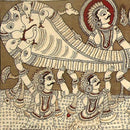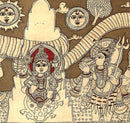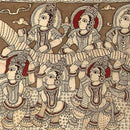The spectacular Kalamkari painting depicts an epochal moment in Hindu mythology with lot of grace and devotion. There is a long anecdote behind the Samudra Manthan. Indra, the king of the Devas, one day met the great sage Durvasa who in turn gave Indra a special garland. Indra put it on the trunk of the elephant. Irritated by the smell of the garland, the elephant threw the garland on the ground. The garland was a dwelling of Sri (fortune) and Indra’s action enraged the sage. He cursed that Indra and all devas will be deprived of all strength, energy, and fortune. As ill luck would have it, the Devas were beaten in many battles by the demons led by king Bali. Devas finally approached Lord Vishnu who asked them to form an alliance with the demons to jointly churn the ocean for the nectar of immortality. According to a deal, both the demons and the Devas will share the nectar of immortality. However, Lord Vishnu told the Devas that he would arrange that they alone obtain the nectar. The churning of the Ocean of Milk was an elaborate process. Mount Mandarachala was used as the churning rod, and Vasuki, the king of serpents, became the churning rope. The demons held the head of the snake, while devas agreed to hold its tail as per instructions from Lord Vishnu. As a result the demons were poisoned by fumes emitted by Vasuki. Despite this, the devas and demons pulled back and forth on the snake's body alternately, causing the mountain to rotate, which in turn churned the ocean. However, once the mountain was placed on the ocean, it began to sink. Vishnu in his second incarnation as Kurma, came to their rescue and supported the mountain on his back. During the Samudra Manthan by the gods and demons, one of the product emerged from the churning was a dangerous poison. This terrified the gods and demons because the poison was so toxic that it might have destroyed all of creation. The devas approached Shiva for help and protection. Out of compassion for living beings, Shiva swallowed the poison in an act of self-sacrifice. However, his consort Parvati who was looking on, terrified at the thought of his impending death, prevented the poison from descending into his body. Thus the poison was stuck in Shiva's throat with nowhere to go, and it was so potent that it changed the color of Shiva's neck to blue. For this reason, he is also called Nilakanta (the blue-throated one; "neela" = "blue", "kantha" = "throat" in Sanskrit). When the heat from the poison had become unbearable Shiva is supposed to have used his trishul to dig for water forming the Gosaikunda lake.
Description
The spectacular Kalamkari painting depicts an epochal moment in Hindu mythology with lot of grace and devotion. There is a long anecdote behind the Samudra Manthan. Indra, the king of the Devas, one day met the great sage Durvasa who in turn gave Indra a special garland. Indra put it on the trunk of the elephant. Irritated by the smell of the garland, the elephant threw the garland on the ground. The garland was a dwelling of Sri (fortune) and Indra’s action enraged the sage. He cursed that Indra and all devas will be deprived of all strength, energy, and fortune. As ill luck would have it, the Devas were beaten in many battles by the demons led by king Bali. Devas finally approached Lord Vishnu who asked them to form an alliance with the demons to jointly churn the ocean for the nectar of immortality. According to a deal, both the demons and the Devas will share the nectar of immortality. However, Lord Vishnu told the Devas that he would arrange that they alone obtain the nectar. The churning of the Ocean of Milk was an elaborate process. Mount Mandarachala was used as the churning rod, and Vasuki, the king of serpents, became the churning rope. The demons held the head of the snake, while devas agreed to hold its tail as per instructions from Lord Vishnu. As a result the demons were poisoned by fumes emitted by Vasuki. Despite this, the devas and demons pulled back and forth on the snake's body alternately, causing the mountain to rotate, which in turn churned the ocean. However, once the mountain was placed on the ocean, it began to sink. Vishnu in his second incarnation as Kurma, came to their rescue and supported the mountain on his back. During the Samudra Manthan by the gods and demons, one of the product emerged from the churning was a dangerous poison. This terrified the gods and demons because the poison was so toxic that it might have destroyed all of creation. The devas approached Shiva for help and protection. Out of compassion for living beings, Shiva swallowed the poison in an act of self-sacrifice. However, his consort Parvati who was looking on, terrified at the thought of his impending death, prevented the poison from descending into his body. Thus the poison was stuck in Shiva's throat with nowhere to go, and it was so potent that it changed the color of Shiva's neck to blue. For this reason, he is also called Nilakanta (the blue-throated one; "neela" = "blue", "kantha" = "throat" in Sanskrit). When the heat from the poison had become unbearable Shiva is supposed to have used his trishul to dig for water forming the Gosaikunda lake.
Payment & Security
Your payment information is processed securely. We do not store credit card details nor have access to your credit card information.








